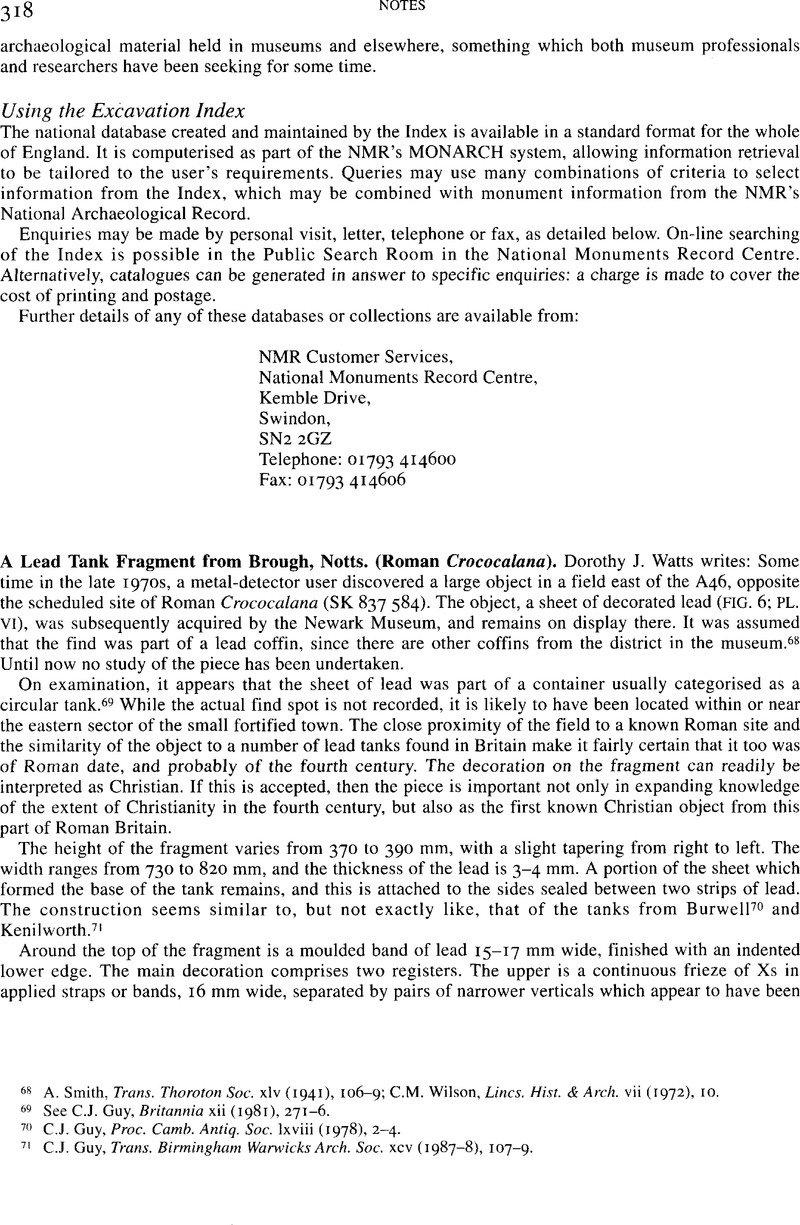Published online by Cambridge University Press: 09 November 2011

68 Smith, A., Trans. Thornton Soc. xiv (1941), 106–9Google Scholar; Wilson, C.M., Lines. Hist. & Arch., vii (1972), 10.Google Scholar
69 See Guy, C.J., Britannia xii (1981), 271–6.CrossRefGoogle Scholar
70 C.J. Guy, Proc. Camb. Antiq. Soc. lxviii (1978), 2–4.
71 Guy, C.J., Trans. Birmingham Warwicks Arch. Soc. xcv (1987–1988), 107–9.Google Scholar
72 See D.J. Watts, Christians and Pagans in Roman Britain (1991), 158–75. A further (undecorated) tank has since been found at Riby, Lines., but its date is uncertain. (Information kindly supplied by Dr Ben Whitwell, Archaeology Unit, Humberside County Council.)
73 See Guy, op. cit. (note 71), table 1 for a summary of sizes of tanks discovered up to 1989.
74 See Watts, op. cit. (note 72), figs 23 (d), (f), 24 (a–e).
75 Watts, D.J., Antiq. Journ. lxviii (1988), 210–22. This paper was subsequently updated in the 1991 publication (Watts, op. cit. (note 72)).CrossRefGoogle Scholar
76 Ancient references include Isidore, Origen 1.3 and possibly Justin Martyr, 1 Apology 60 and Julian, Misopogon 357A
77 D.E. Farwell and T.I. Molleson, Poundbury. 2. The Cemeteries (1993), fig. 83.40 in Grave 1339.
78 Keen, L. (ed.), Proc. Dorset Nat. Hist. Arch. Soc. ci (1981), 133.Google Scholar
79 See Watts, op. cit. (note 72), 173–8. The grave belonged to a male, not a female, as reported in that publication.
80 e.g. Municius Felix, Octavius 29.6; and possibly Barnabas, Epistle 12.2.
81 e.g. Isidore, Etymologiae 1.3.7. See Watts, op. cit. (note 72), 177 and notes.
82 e.g. W.M. Ramsay, Cities and Bishoprics of Phrygia 1. 1 (1897), 526–7; O. Marucchi, Christian Epigraphy (1910, reprint 1974), 59; Sulzberger, M., Byzantion ii (1925), 393–7.Google Scholar
83 CIG 39020. This seems to be a variant on the formula ἔσται ατῷ πρòσ τòν θɛóν (‘he will have to account to God’), which was common in Christian inscriptions in Asia Minor (Ramsay, op. cit. (note 82), 514–16).
84 DeRossi, G.B., Inscriptiones Christianae Urbis Romae I (1861), 16, no. 10.Google Scholar
85 DeRossi, G.B., La Roma Sotterranea Cristiana II (1867), pl. xxxix, no. 30.Google Scholar
86 Sulzberger, op. cit. (note 82), 397.
87 e.g. P.Oxy. 1.126 (A.D. 572), 136 (A.D. 583), 137 (A.D. 584), 138 (A.D. 610–11). This last document, although secular in nature, begins with a Christian invocation.
88 e.g. E. Diehl, Inscriptiones Latinae Christianae Veteres 1 (1925), no. 841 (A.D. 584).
89 The monogram is used only as a symbol in these examples.
90 See Watts, op. cit. (note 72), 151; 245, n. 9.
91 Now RIB (Vol. 11) 2417.41.
92 G. Clarke, Pre-Roman and Roman Winchester Part II: The Roman Cemetery at Lankhills (1979), 430; fig. 82.256.
93 Watts, op. cit. (note 72), passim.
94 ibid., 163–6.
95 H. Child and D. Colles, Christian Symbols (1971), 27.
96 See Watts, op. cit. (note 72), 169, for the main theories, and for further details of the argument presented in this present paper.
97 V.C.H. Notts. II (1970), 11–15.
98 B. Burnham and J. Wacher, The ‘Small Towns’ of Roman Britain (1990), 35, 315.
99 Woolley, T.C.S., Trans. Thornton Soc. x (1910), 63–72.Google Scholar
100 Information kindly supplied by Mr V. Radcliffe.
101 Watts, op. cit. (note 72), ch. 111 et passim.
102 This item is now in the British Museum.
103 Guy, op. cit. (note 69), 275.
104 Watts, op. cit. (note 72), 221–7.
105 My thanks are extended to The University of Queensland and the Australian Research Council for funding this research, to Mr Michael Jones and the City of Lincoln Archaeology Unit for organising and supplying the drawing and photograph, and to Newark Museum for permission to publish the object.